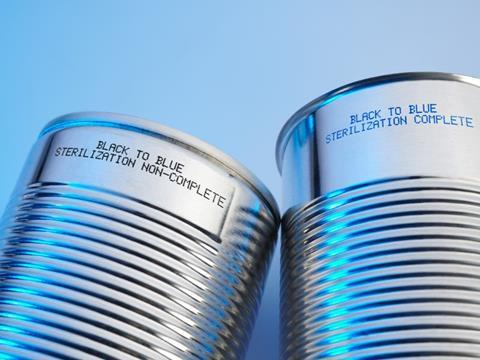
A thermochromic ink that changes colour at high temperatures now can offer food manufacturers a more reliable coding method, with a more obvious colour change, to indicate correct sterilization of packaged food products, Markem-Imaje has announced
Designed for retort sterilization of filled cans or plastic pouches, the ink changes from black to blue when the food package reaches the correct temperature of between 115 and 125oC.
With the growing regulatory demands by governments for proper coding and marking on cooked food products, there is a growing interest in product authenticity and quality assurance.
This can be especially important in the food industry, where heat-treated ready meals are becoming more popular. A particular need is for a method that can be used on the increasingly popular plastic pouches used for such meals as well as baby food and pet food.
Thermochromic inks that change colour when the treated product reaches the required temperature support this need. While thermochromic inks cannot guarantee that sterilization has actually occurred, they assist manufacturers by providing a good indication that the process has taken place. While there have previously been challenges associated with this form of coding, as discussed below, today’s launch addresses those issues.
Print on all surfaces
Markem-Imaje’s MS596 thermochromic ink can be used to print on both metal cans and plastic film. With excellent adhesion to polyolefin pouches, no pre- or post-treatment of the packaging material is required, the company says,
Giving good contrast on the dedicated white printing area, the ink offers a clear colour change from black to blue at retort temperature. It has an operating temperature from 5 to 40oC , ensuring it can work effectively in a wide range of environmental conditions.
Used in the company’s 9450 continuous inkjet printer, the ink also contributes to printing reliability. Unlike some earlier generations of thermochromic ink, today’s innovation will not change colour prematurely due to temperature effects from the printer itself, rather than the sterilization process.
The ink also "aids maximum production throughput" with a drying time of only one second on all materials. An issue with previous generations of thermochromic ink was smearing of the printed code, which could lead to the information becoming illegible. MS596 resists smearing to maintain high coding legibility and is less affected by oil and grease residues or water during the retort process.
Low toxicity
Given this ink can come into contact with food, all raw materials used to create it have been closely chosen in line with the Swiss Ordinance which helps ensure inks are safe to use in such situations.
The ink is formulated and manufactured in accordance with the EuPIA (European Printing Ink Association) “Guideline on printing inks applied to the non-food contact surface of food packaging materials and articles” and complies fully with the EuPIA Exclusion Policy.
It does not feature ingredients dangerous to aquatic life nor does it contain methanol which is known to be highly toxic to the human nervous system. The company is keen to highlgiht that no ink launched by Markem-Imaje within the last 10 years contains methanol.











